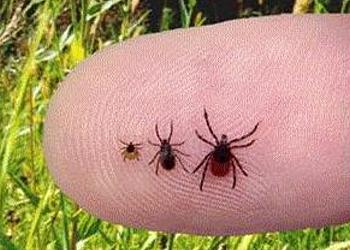
They are so tiny you may not notice them attaching themselves to your exposed skin in summer
Ticks that spread Lyme disease are definitely in the Hamilton - Dundas area, warns a study accusing the public health department of "under-reporting" the danger and giving "the false impression" that acquiring the illness here is unlikely.
"Lyme disease-carrying black-legged ticks pose a public health risk in the Dundas area and the surrounding Hamilton-Wentworth region," concludes the research by Lyme Ontario published in the International Journal of Medical Sciences.
A Lyme Ontario researcher found 41 per cent of black-legged ticks collected in Dundas over two years were infected with Borrelia burgdorferi — the bacteria that causes the disease.
The results are in stark contrast to a report by Hamilton Public Health Services finding no infected ticks during a five-year period in an area 20 times the size, states the study.
"We point out the difference between what the health unit is saying and what we found out in the field," said lead researcher John Scott. "There is a notable difference … of over 600 times. I would say their surveillance program isn't working."
The study calls for tick and Lyme disease warning signs, deer management strategies and advisories to health-care providers.
"Public Health Services appreciates the work of local researchers with respect to black-legged ticks in Dundas," said Dr. Jessica Hopkins, an associate medical officer of health, in a statement. "We have just become aware of the recent publication and are in the process of understanding the study and its implications."
Hamilton is not listed as a Lyme disease risk area by Public Health Ontario. Wrong! by about 600%.
Local doctors and hospitals were told "Hamilton is not an endemic area and acquiring Lyme disease in the Hamilton area is unlikely" in a medical advisory from the city's public health department in August 2013 — the same time the Lyme Ontario researchers were finding infected ticks.
"They are downplaying the health risks in this area," said Stoney Creek Lyme patient Nancy Diklic. "I believe I was bitten locally going on 11 years ago. To this day, the local public health unit says Hamilton is not an endemic area."
She wants proper warnings so residents can take precautions such as covering exposed skin, using insect repellents, doing full bodychecks for ticks, showering within two hours of being outdoors and removing ticks within 24 to 36 hours.
"If we are aware that it is possible to get it in our area, we can take preventive measures," Diklic said. "Then you won't have to suffer the ill effects I've been dealing with the past decade."
The study in 2013 and 2014 in a 56-square-kilometre area bordered by Highway 99, Highway 52, Highway 5 and Rock Chapel Road asked local veterinarians and pet groomers to collect black-legged ticks from dogs and cats with no history of travel. Specimens were also submitted by local residents and collected by flagging. In total, 12 of the 29 ticks collected were positive for Borrelia burgdorferi.
"The migratory song birds are bringing them in this time of year," Scott said.
High deer counts in the Dundas area of up to four times the number considered ecologically desirable exacerbates the abundance of ticks. A wide variety of acorn-bearing oaks also contributes.
But mainly it was requests from area patients that prompted Lyme Ontario to fund the study to find out once and for all if there are infected ticks in Hamilton.
"People were contracting Lyme disease but they couldn't get any recognition," Scott said.
The research scientist has Lyme disease himself. He describes it as like having dementia and arthritis at the same time.
"You don't want to live like I'm living," he says, giving his age as "70 going on 170."
The study found the prevalence of infected ticks in Hamilton to be consistent with parts of the United States that have rates of 27 per cent to 47 per cent.
"Advocacy and surveillance programs conducted by the local public health unit fail to reflect and authenticate" the presence of Lyme disease-carrying ticks, concludes the study. "And give the false impression that there is no Lyme disease in the Hamilton-Wentworth area."
Don't believe everything you read published by government funded agencies. And be careful out there.
Don't believe everything you read published by government funded agencies. And be careful out there.






PIC , this is a much needed post , not only the Hamilton area , everywhere there is animals or wild -life [squirrels / rabbits ETC] go to your local garden shop and ask for advice .
ReplyDeleteSo true about what the government writes , I bet some have never seen a tick or any of the shit they write about .
Love BAW
Right PIC
ReplyDeleteWhat is up with Public Health Ontario? They are supposed to protect us from all outside health dangers. They are blatantly lying. I hope some heads roll. Our kids play outside all summer.
love PIC